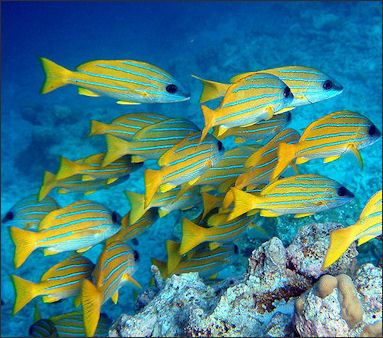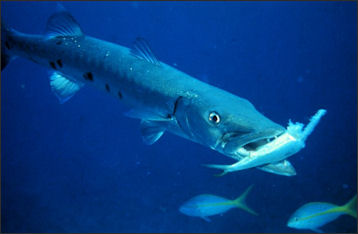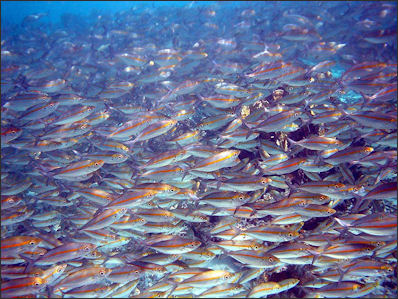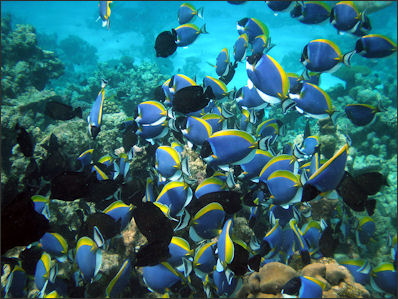Home | Category: Reef Fish / Ocean Fish
FISH BEHAVIOR

schooling fish Fish can be solitary, social (associates with others of its species; forms social groups), territorial (defend an area within the home range), diurnal (active during the daytime), nocturnal (active at night), crepuscular (active at dawn and dusk), motile (move around as opposed to being stationary),nomadic (move from place to place, generally within a well-defined range), migratory (make seasonal movements between regions, such as between breeding and wintering grounds),sedentary (remain in the same area), fossorial (engaged in a burrowing life-style or behavior),, colonial (living together in groups or in close proximity to each other) and have dominance hierarchies.[Source: Nicholas White, Animal Diversity Web (ADW) /=]
According to Animal Diversity Web (ADW) fish display considerable complexity in their ability to perceive their environment and communicate with other individuals, yet until recently it was assumed that fish had negligible cognitive ability. Current research, however, indicates that learning and memory are integral parts of fish development and rely on processes very similar to those of terrestrial vertebrates. Experiments have shown, for instance, that individuals can remember the exact location of holes in fishing net years after exposure, and that fish in schools learn faster by following the lead other individuals. Some researcher believe that the cognitive ability of some fishes is even comparable to that of non-human primates. /=\
Related Articles: FISH: TYPES, HISTORY AND DEFINITIONS ioa.factsanddetails.com ; FISH CHARACTERISTICS: ANATOMY, BREATHING AND DIGESTION ioa.factsanddetails.com ; FISH PERCEPTION AND COMMUNICATION ioa.factsanddetails.com FISH REPRODUCTION, MATING, DEVELOPMENT AND PARENTING ioa.factsanddetails.com ; OCEAN PREDATORS AND FISH FEEDING BEHAVIOR ioa.factsanddetails.com
Websites and Resources: Animal Diversity Web (ADW) animaldiversity.org; National Oceanic and Atmospheric Administration (NOAA) noaa.gov; Fishbase fishbase.se ; Encyclopedia of Life eol.org ; Smithsonian Oceans Portal ocean.si.edu/ocean-life-ecosystems ; Woods Hole Oceanographic Institute whoi.edu ; Cousteau Society cousteau.org ; Monterey Bay Aquarium montereybayaquarium.org ; MarineBio marinebio.org/oceans/creatures
Fish Sleep
While most fish rest by reducing their activity and metabolism, fish "sleep" is different from that of land mammals. The nature of fish "sleep" is an area of active research. While fish do not sleep in the same way that land mammals sleep, most fish do rest. A Pacific sand lance employs a unique strategy of burrowing into sand to rest and conserve energy, and to avoid predation. [Source: NOAA]
Many species of fish engage in aestivation (prolonged torpor or dormancy such as hibernation) and have daily torpor (a period of reduced activity, sometimes accompanied by a reduction in the metabolic rate, especially among animals with highmetabolic rates)
Research shows that fish may reduce their activity and metabolism while remaining alert to danger. Some fish float in place, some wedge themselves into a secure spot in the mud or coral, and some even locate a suitable nest. These periods of "suspended animation" may perform the same restorative functions as sleep does in people.
According to Animal Diversity Web (ADW): A unique feature of some parrotfishes is the production of a mucous envelope at night before resting. The envelope takes about 30 minutes to make and is open at both ends to allow water flow. The envelopes have a nasty smell and taste. At night parrotfish that use the filmy, mucus envelopes enter into a sleep-like state inside cocoons that covers them from head to foot. Scientist once thought the cocoon hid the parrotfish's scent from nocturnal predators. But that doesn't seem to be the case and scientists now are not sure why they have the cocoon.”
This mucus envelope may also serve as an early warning system, allowing the parrotfish to flee when it detects predators such as moray eels disturbing the membrane. The skin itself is covered in another mucous substance which may have antioxidant properties helpful in repairing bodily damage, repelling parasites, and providing protection from UV light. [Source: Wikipedia]
Fish Aggression and Territoriality
Nicholas White wrote in Animal Diversity Web (ADW): One common characteristic of fish is aggressive behavior, which results from competition for valuable resources, such as feeding, refuge and mating territories, mates, eggs, and young. One form of aggressive behavior is dominance hierarchies, which are found in many groups (e.g. catfishes , minnows , cods , ricefishes , topminnows , cichlids , wrasses , blennies , and boxfishes). [Source: Nicholas White, Animal Diversity Web (ADW) /=]
The hierarchy is determined through a variety of factors, including size, sex, age, previous residency, and previous experience. In most ray-finned species males dominate females, subordinate individuals are relegated to suboptimal sites in terms of cover availability, current velocity and prey densities, and dominant individuals have favorable habitats, higher feeding rates and tend to remain dominant.

barracuda feeding on a smaller fish Another aggressive behavior is territorial (defend an area within the home range),ity, which is found in numerous fish and spread across a wide variety of groups, such as freshwater eels , cyprinids , knifefishes , salmonidsfrogfishes , rockfishes , sculpins , sunfishes and black basses , butterflyfishes , cichlids , damselfishes , barracuda , blennies , gobies , surgeonfishes and labyrinthfishes. Territorial interactions primarily occur along territorial boundaries and usually involve displays, vocalizations, chasing, and biting as a last resort. As with dominance hierarchies, prior experience, previous residency, and individual size are all important in determining the outcome of an altercation./=\
Do Fish Experience Pain?
A question that some have addressed — including Kurt Cobain in a Nirvana song — is do fish feel pain when they are caught with a hook? For a long time it was argued that they either didn’t feel anything or the pain they felt was minimal. In a study by University of Edinburgh researchers published in 2003, mouth area of rainbow trout were injected with bee venom, acid and other substances and scientists found that fish possess neurons for detecting pain that are almost identical to those of humans. The study found that fish also responded physically to the pain by wriggling from side to side, rubbing their mouths against their tanks, experiencing accelerated heart rates and abstaining from eating. Critics of the study argue that avoidance reactions does not necessarily mean the fish experienced pain and point out that fish lack the part of the brain that humans have that registers pain and suffering. In 2009 scientists at Purdue University injected some goldfish with morphine and some were given a saline solution. Both groups were subjected to “unpleasant temperature.” The scientists concluded the fish could feel pain.
On whether fish experience pain or not, Victoria Braithwaite, a behavioral biologist at Edinburgh University, wrote in the Los Angeles Times, “Every year, sportsmen around the world drag millions of fish to shore on barbed hooks. It's something people have always done, and with little enough conscience. Fish are ... well, fish. They're not dogs, who yelp when you accidentally step on their feet. Fish don't cry out or look sad or respond in a particularly recognizable way. So we feel free to treat them in a way that we would not treat mammals or even birds. [Source: Victoria Braithwaite, Los Angeles Times, October 8, 2006]
But is there really any biological justification for exempting fish from the standards nowadays accorded to so-called higher animals? Do we really know whether fish feel pain or whether they suffer -- or whether, in fact, our gut sense that they are dumb, unfeeling animals is accurate? Determining whether any type of animal really suffers is difficult. A good starting place might be to consider how people feel pain. When a sharp object pierces the human body, specialized nerve endings called nociceptors alert us to the damage. Incredibly, no one ever seems to have asked before whether fish have nociceptors around their mouths. My colleagues and I in Edinburgh, Scotland, recently looked in trout and found that they do. If you look at thin sections of the trigeminal nerve, the main nerve for the face for all vertebrates, fish have the same two types of nociceptors that we do -- A-delta and C fibers. So they do have the necessary sensory wiring to detect pain.
And the wiring works. We stimulated the nociceptors by injecting diluted vinegar or bee venom just under the skin of the trout. If you've ever felt the nip of vinegar on an open cut or the sting of a bee, you will recognize these feelings as painful. Well, fish find these naturally irritating chemicals unpleasant too. Their gills beat faster, and they rub the affected area on the walls of their tank, lose interest in food and have problems making decisions.
When I have a headache, I reach for the aspirin. What happens if we give the fish painkillers after injecting the noxious substances? Remarkably, they begin to behave normally again. So their adverse behavior is induced by the experience of pain.

fish brain
If Fish Do Feel Pain How Intelligent Are They?
On whether fish feel pain Braithwaite wrote in the Los Angeles Times, “But just because fish are affected by pain, does that mean they actually feel it? To answer that, we need to probe deeper into their brains (and our own) to understand what it means to feel pain. To determine what fish go through mentally when they experience painful stimuli, we also need to determine whether they have a capacity to feel emotion and to suffer. This is a much harder problem. It goes to the very heart of one of the biggest unresolved issues in biology: Do nonhuman animals have emotions and feelings? Are nonhuman animals conscious?
Scientists and philosophers have long debated consciousness and what it is and whether it is exclusively human. There are multiple definitions and, frankly, we haven't really come to grips with what it means to be conscious ourselves. Are we conscious because we are capable of attributing mental states to others, or perhaps because we have a qualitative awareness of feelings, whether positive or negative? And if we can't define our own consciousness, can we expect to detect it in fish? Perhaps not, but we can look for behaviors and abilities that we believe contribute to human consciousness -- for example, complex cognitive abilities and specialized brain regions that process emotion and memory.
It turns out that the stereotype of fish as slow, dim-witted creatures is wrong; many fish are remarkably clever. For example, they can learn geometrical relationships and landmarks -- and then use these to generate a mental map to plan escape routes if a predator shows up. And their brains are not as different from ours as we once thought. Although less anatomically complex than our own brain, the function of two of their forebrain areas is very similar to the mammalian amygdala and hippocampus -- areas associated with emotion, learning and memory. If these regions are damaged in fish, their learning and emotional capacities are impaired; they can no longer find their way through mazes, and they lose their sense of fear.
None of this tells us that fish are “conscious,” but it does demonstrate them to be cognitively competent: They are more than simple automata. So do we have to change the way we treat fish? Some still argue that fish brains are so less well developed than those of birds and mammals that it isn't possible for fish to suffer. In my view, that case is not proven.
Moreover, we actually have as much evidence that fish can suffer as we do that chickens can. I think, therefore, that we should adopt a precautionary ethical approach and assume that in the absence of evidence to the contrary, fish suffer. Of course, this doesn't mean that we necessarily must change our behavior. One could reasonably adopt a utilitarian cost-benefit approach and argue that the benefits of sportfishing, both financial and recreational, may outweigh the ethical costs of the likely suffering of fish.
But I do find it curious that it has taken us so long even to bother to ask whether fish feel pain. Perhaps no one really wanted to know. Perhaps it opens a can of worms -- so to speak -- and begs the question of where do we draw the line. Crustacean welfare? Slug welfare? And if not fish, why birds? Is there a biological basis for drawing a line?
Fish Migrations
According to Animal Diversity Web (ADW): Many fish exhibit migratory (make seasonal movements between regions, such as between breeding and wintering grounds), behavior; daily migrations are usually related to feeding or predator avoidance while longer migrations are usually for reproduction purposes. Some fishes stay within saltwater (oceanodromous) or fresh water (potamodromous) their entire lives, while others migrate between the salt and fresh water as part of their life cycle (e.g. to reproduce) or to feed (diadromous). [Source: Nicholas White, Animal Diversity Web (ADW) /=]
Diadromous species can be broken down into three types: those in which growth occurs primarily in saltwater but move into freshwater to spawn (termed anadromous) — e.g. salmon; those in which growth occurs primarily in freshwater but move into saltwater to spawn (termed catadromous) — e.g. anguillid eels; and those that migrate between salt and fresh water for purposes other than spawning, such as feeding (termed amphidromous) — e.g. various gobies , sleepers and galaxiids.
While many fish migrate well outside their home range — in many cases hundreds of kilometers, against current and even up waterfalls — they have remarkable abilities to find their way back. For instance, salmon can remember the odor of the rivers they originated from, as well as the odor of other rivers they have passed during migration. In addition, salmon (among other ray-finned fish) use currents, salinity and temperature gradients, and topographic cues (buoys or islands) for orientation. Tidepool sculpins separated from their home pool by 100 meters can also find their way back using olfactory and visual cues. While younger fish rely on visual or olfactory cues, some older fish, even if removed from their original locale for multiple years, only require visual cues, utilizing a cognitive map to navigate. /=\
Fish Schooling (Shoaling)

School of Pterocaesio chrysozona in Papua New Guinea Many fish congregate in large schools (shoals) often with thousands of members that move and feed in unison. Some schools reach a kilometer or more in length and turn the surface of the ocean into a wriggling, churning mass. When a school reaches the size of several kilometers and has hundreds of millions of individuals is becomes a shoal of fish.
Only bony fish have the skill and control to swim in schools. Fish that swim in a group but behave independently are referred to as an aggregate. In schools each fish follows a course parallel to its neighbor, using its vision, hearing and lateral-line system to maintain its position and adjust to movement quickly.
Why do fish school? There are several reasons and they vary from species to species. Goatfish for example scour they ocean bottom as a pack, looking for food. If one member finds food it can alert the others. Surgeonfish on the other hand use their numbers to outmaneuver territorial fish, like damsel fish, for the best eating spots on reefs.
According to Animal Diversity Web (ADW): When fish group together, either for spawning migration, feeding or protection, they sometimes form shoals (schools). While in some cases fishes simply form aggregates (no social interaction but a mutual attraction to resources), shoaling represents a continuum of fascinating social behaviors. Schooling, in which individuals form a synchronized, polarized group, is actually an extreme form of shoaling and represents one of many types of shoal formation. The formation changes shape depending on whether the group is resting, foraging, traveling, spawning or avoiding predators. Approximately 25 percent of fishes shoal throughout life (e.g. herrings , anchovies , minnows , silversides) and about half form shoals at some point during their lifetime. /=\
How Fish School
How do fish school? According to marine biologist Joseph Levine, "some rely on sight and distinctive body-color patterns. Most have special sense organs on their skins that can “hear” the movement of their cohorts through the water around them. Others talk to one another in private languages of clicks, grunts, and growls. And still others communicate with electric pulses that they generate in highly specialized muscles." [Source: Joseph S. Levine, Smithsonian]
"Large schools of open water fish...may not have predetermined “leaders.” Instead, decisions are somehow made by one or more individuals within the school signaled by behavior changes that they have detected food, predators or better water conditions. The message spreads from those individuals like a wave across the group, gradually affecting everyone in the crowd."

fish school baitball A study of shoaling herring off the northeast United States in an area called the George Bank by researchers at MIT’s Center of Oceanic Engineering indicates that shoaling activity seems to be set off by darkness: at sunset herring in widely scattered groups begin swimming 20 times closer together than they normally do and this sets off a chain reaction that brings fish together from a large area into shoals that reach 40 kilometers across and have a depth of 30 meters. During the night the shoal moves from deep water into sallower water and break up into as the sun rise. Not only does forming such large groups over projection from predators and also helps the herring developed their eggs in synchrony and permits mass spawning.
Studies by Iain Couzin at Oxford University found that a large group — say a school of migrating fish — can head to a desired direction with only a couple of individuals knowing the way and each member of the group in two instincts; 1) staying with the groups; and 2) moving in a desired direction. Two leaders may try to pull the school in different direction but swarm with keep together.
Couzin told the New York Times, “As we increased the difference of opinion between the informed individuals, the groups would spontaneously come to a consensus and move in the direction chosen by the majority. They can make these decisions without mathematics or even recognizing each other or knowing that a decision has been made.”
A school that moves as a group in one direction can form as fish begin to orient themselves more strongly with other fish in the group. A moving torus — wide donut shaped formation — can form if they try to orient themselves to their closest neighbors. A swarm forms if individuals both repel and attract one another but do not try to orient themselves to their neighbors.
On the applications of what has been learned about schooling fish John Dabiri, an assistant professor of aeronautics and bioengineering at Caltech and MacArthur Award winner, said, “Fish like trout or tuna or mackerel will often swim in groups in pretty regular patterns. One of the leading hypotheses for why they do this is that the individual fish can interact with the vortices that are being shed by the tails of their neighbors and go from point A to point B using less energy as a group than if they were going individually through the water. We tested a mathematical model to describe what arrangement of the fish in a school works for this energy savings — except instead of fish, we had these wind turbines. We did a field demonstration this summer out in Lancaster, and were able to show that using this bio-inspired design for this wind farm, we could actually perform much better than existing technologies that are out there.
Schooling Fish and Predators

Surgeonfish in the Maldives Fishes in schools are safer than individuals because they and other fish looking out for predators. There is also some safety in numbers in that it is difficult for a predatory to single a single fish in a large mass. Swimming in schools can also help fish more easily find mates and seek food.
Most fish species seem to school as a means of protection from predators. Like lions attacking a group of gazelles, predatory fish only inches away from a school seem to have difficult catching individual fish because they motion of the group confuses them and they have difficulty selecting a victimswhen all the potential victims look the same.
Daniel Grunbaum, a biologist at the University of Washington told National Geographic, “It is much harder for a predator to avoid being spotted by a thousand fish than it is to avoid being spotted by one. News that a predator is approaching spreads quickly through a school because fish sense from their neighbors that something going on.”
Peter Miller wrote in National Geographic, “When a predator strikes a school of fish. The group is capable of scattering in patterns that make it almost impossible to track any individual. It might explode in a flash, create a kind of moving bubble around the predator, or fracture into multiple blobs, before coming back together and swimming away.”
Study Finds Fish Leaders Are Born, Not Made
A study of fish behavior published in 2013 found that leadership is an innate quality and predicted trouble in animal social groups, including human ones, when natural roles are reversed. AFP reported: Groups tend to perform better with a combination of willing followers and strong leaders, which in most animal species are bolder, more extroverted individuals. But incentives, like higher salaries for humans, can cause natural followers to become leaders, and scientists have long debated the desirability of such role reversal. [Source: AFP, August 28, 2013]
To probe whether natural followers can be turned into leaders and vice versa, a research team studied stickleback fish — a group foraging species known to have bold and shy individuals. First, they studied the fish in large laboratory tanks for several weeks to separate the leaders from the followers. Leaders were more prone to leave the deep, covered, "safe" area of a tank and travel through "risky", shallow waters to get to a feeding station.
The fish were then divided into pairs, each with one bold and one shy member, the team wrote in the journal Proceedings of the Royal Society B. In one experiment, the fish were rewarded with food for displaying their natural behaviour — the leader for initiating a trip and the follower for trailing behind. In a second, they were rewarded for role reversal — the shy fish for each time it initiated a foraging trip and the bolder one for following. "Our prediction was that bold individuals would perform poorly when forced to adopt the role of follower, considering that they are less responsive to other individuals' behaviour," study co-author Shinnosuke Nakayama of the University of Cambridge's zoology department told AFP by email.
The opposite turned out to be true: leader fish were much quicker to adopt a follower role than the other way round. "Fish can learn to follow but struggle to learn to lead," said Nakayama of the findings. "We found that leaders are born, not made," added a study summary. The role reversal also had an impact on group success. When incentivised to act against their natural instincts, fewer foraging excursions resulted in both members of a pair being fed.
Image Sources: Wikimedia Commons; YouTube, Animal Diversity Web, NOAA
Text Sources: Animal Diversity Web (ADW) animaldiversity.org; National Oceanic and Atmospheric Administration (NOAA) noaa.gov; Wikipedia, National Geographic, Live Science, BBC, Smithsonian, New York Times, Washington Post, Los Angeles Times, The New Yorker, Reuters, Associated Press, Lonely Planet Guides and various books and other publications.
Last Updated March 2023



